I’m going up this way tomorrow (not in it).
Burn’s a good thing.
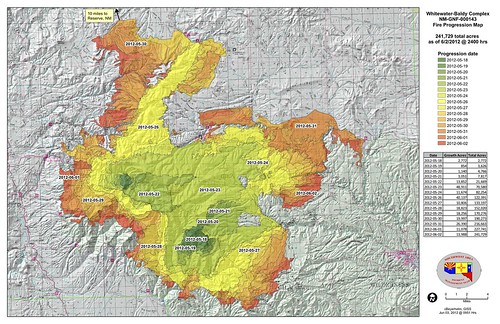

ANIMALS, PEOPLE AND THOSE IN BETWEEN
I just read this passage written by Harley Shaw, in the 2002 introduction for The Wolf in the Southwest, the Making of an Endangered Species (1983) by David E. Brown. Shaw is a research biologist specializing in mountain lions in SW NM:
“Eliminating species leads to intellectual dead ends. Once a creature is gone, we no longer have reason to understand it. Our world becomes simpler, and our minds simpler with it. Problem-solving is an open-ended activity. Interacting with a species provides a means for intellectual growth, eliminating it simply leaves another blank spot – on earth and in our minds.”
The air smells like campfire.
But it’s not trivial like that.
A truck speeds by and picks the scent up from where it settled, or brings the smoke along from where it came.
I met some smoke jumpers in the coffee shop at 7 am.
I also met a man from Kansas in Silver City:
he is apprenticed to a local plant medicine man of great repute for several weeks, learning about herbalism and plant ritual.
“I love wolves” he told me. “They remind us to be connected to wilderness and the earth.”
can’t they be of NO service to us whatsoever?
There’s a Saturday farmers market, and I bought some very fresh, clean goat milk panela, russian kale, radishes, garlic scapes, young broccoli, Aracana hen eggs.
Farmers like everywhere. Many beautiful Gaia types.
Everybody here is really friendly. Not shit-grin friendly, but genuinely happy to stop and talk. Lots of benches around town, and people swapping stories outside the plenitude of cafes. There’s a breeze but it’s freaking hot, so best move slow. No getting whirled.
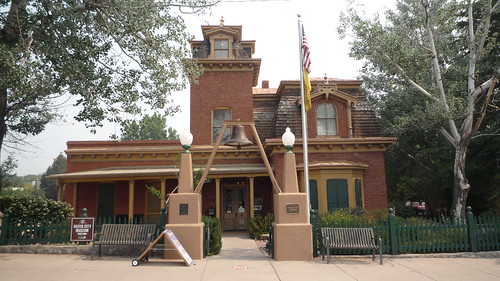
At the Silver City Museum, the super friendly volunteer at the desk asked me where I am from. When I said Brooklyn, he told me he lived in Staten Island in the 1970s. “What did you do there?” “I was in a cult. Children of God. Criminals.” I know a bit too much about them from one of my students.
Bought some supplies at the co-op, another friendly place, with reasonable prices (versus my $5.65 latte this morning) on bulk, elixirs, organics, probiotics, and limes… I’m gonna eat nothing but elixirs and raw vegetables.
Western New Mexico University Museum has a very large collection of Mimbres pottery. It’s in a beautiful cavernous old wooden building on campus, but I was not allowed to take any pictures.The displays are old-school archeology with big run-on sentences in all-caps vinyl letters that explained everything so well. I wonder why the pots selected for display omit the birth scenes, and the luridly huge-phallused pieces and copulations, or any predators (like bear).
There was heat and altitude to collapse from…
nothing like a siesta…
I drove to buy some beer and also up Pinos Altos, in the direction of the Gila Cliff Dwellings (which are closed because of the fires). I went about 20 miles north, to the start of the Trail of the mountain Spirits or some such.
I crossed the continental divide,
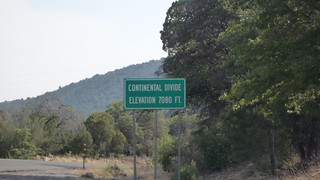
and saw the old Pinos Altos mining town, and then stopped for a micro hike. Turned out to be the Continental Divide trail… I got about 50 yards when I flushed a group of vultures who wheeled low and fast around me, seemingly annoyed. The wind and crickets were symphonic.


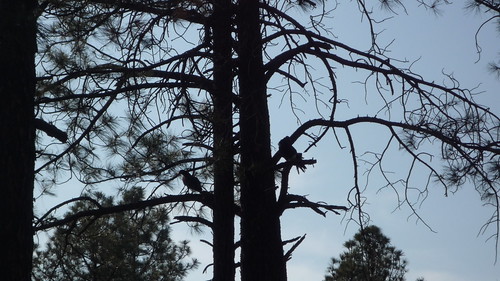
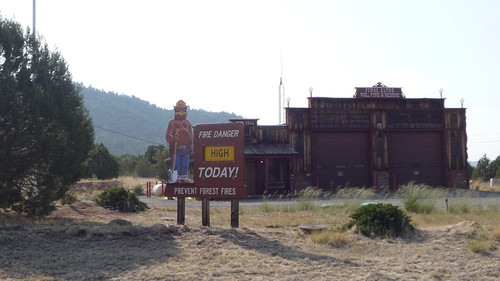
Thanks Walmart. There’s shade and a party in this hat.
Today’s bag was full of:

From the air, the smoke stretches as far as the eye can see. On the ground, firefighters talk about the steep canyons that keep them from directly attacking what has become the largest wildfire in New Mexico’s recorded history and the largest currently burning in the country.
Sure, things might look bad. But to land managers and scientists, the record-setting blaze represents a true test of decades of work aimed at returning fire to its natural role on the landscape — a test that comes as many Western states grapple with overgrown forests, worsening drought and a growing prospect for more megafires…
Starting in the early 1970s, the Gila has been leading the way when it comes to implementing such an active fire management strategy. Instead of immediately dousing flames in the wilderness, forest managers have let them burn as long as conditions are favorable.
The question that the Whitewater-Baldy fire is expected to answer is whether that strategy will pay off with more natural, less intense fires.
“There’s a great opportunity here to study a fire like this,” said Matthew Rollins, the wildland fire science coordinator with the U.S. Geological Survey’s National Center in Virginia.
“The opportunity exists to look at how this fire has behaved differently in terms of vegetation mortality, effects on wildlife and fish habitat and water quality,” Rollins said. “We can study how it burned in the wilderness relative to areas with other types of fire management strategies and other types of ignition patterns…”
The U.S. Fish and Wildlife Service is also monitoring two packs of endangered Mexican gray wolves that are situated to the north and east of the fire. Last year, wolves in Arizona were able to escape the massive Wallow fire with their pups, but it’s unclear how mobile the packs in New Mexico are since their pups are much younger.
The fire is about 15 percent contained, which much of that being on the fire’s northern and northwestern flanks.
I flew from LGA to Denver.
I found the tornado shelter sign
in the women’s bathroom disarming.
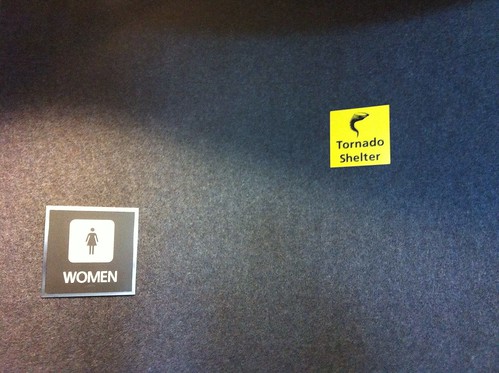
Then flew from Denver to Albuquerque,
and then drove 5 hours south and west.
First scorched earth – 98 degrees
soft hills and naked rock rising like a dead sea,
140 miles to Truth or Consequences
(the town was founded by Bob Barker)
where I bought a small saw and a straw hat at Walmart
(which wasn’t there 19 years ago
when I spent my birthday in
a tatty wooden tub containing
a hot spring the Rio Grande).

Then I turned the fancy little Subaru Outback
towards the west, and drove up and up and up
through the JEWELS of alpine desert mountains
(an inland island ecology,
the largest of which are in the Gila,
collectively known as the Sky Island Region)
on curvacious roads at 15 MPH
and at a brief apex,
the temperature dropped to 80 degrees
but then I wound back down and down,
until I was in a high valley of grasses and chollo in bloom

past an enormous open pit copper mine, the Santa Rita
to Silver City, N.M.
“Gateway to the Gila,”
well over 5,000 feet up, in the Chihuahuan desert

Fires sparked by lightning 2 weeks ago in the Gila have left the air in this high valley smokey, evenly hazy and taupe. Over 300 square miles had burned as of this morning. This is healthy, not a tragedy, right? But it’s stressful for all the animals, esp the human ones. 1,200 fire fighters are in there trying to contain or squelch bits of the rampage. A lot of the park roads are closed, as is the Gila Cliff Dwellings Monument. Bummer. In tourist season, this is a blow, especially with the geographically impaired (myself included), for whom it’s easy to surmise that the state is on fire or at least at risk of smoke inhalation. And people have been evacuated from towns. What is happening with the cattle who graze nearby?
I’ll be here for a 2 week residency researching the Mexican gray wolf reintroduction program, supported by ISEA and the New Mexico Wilderness Alliance. Instigated by a gracious talented and expert host: Michael Berman.
I don’t really know how to give some simple context for this project. I reach points where I can, then slip back into the murk of positions, territories, symbolism, and overlapping realities. And I am totally new to this: to facing issues surrounding public land rights, private land rights, shifting land rights, ideas and ideals about wilderness, and the politics and on-the-ground situation of this (or any) wolf reintroduction program.
The players: “enviros,” conservationists (some make a distinction, the former being extremist the latter being ecosystem people), cattle ranchers, government agents, non-profits, and politicians.